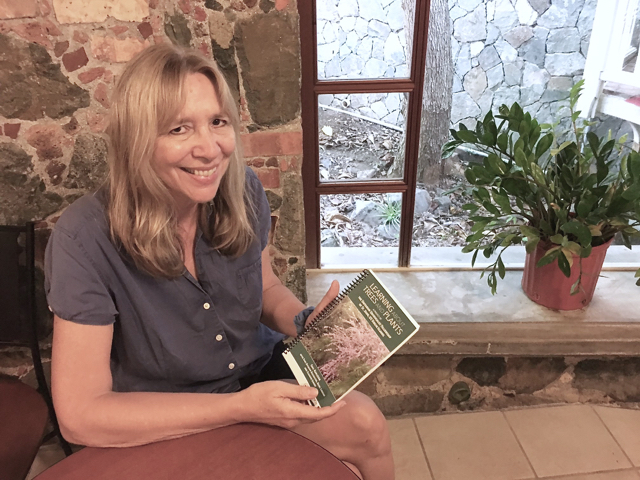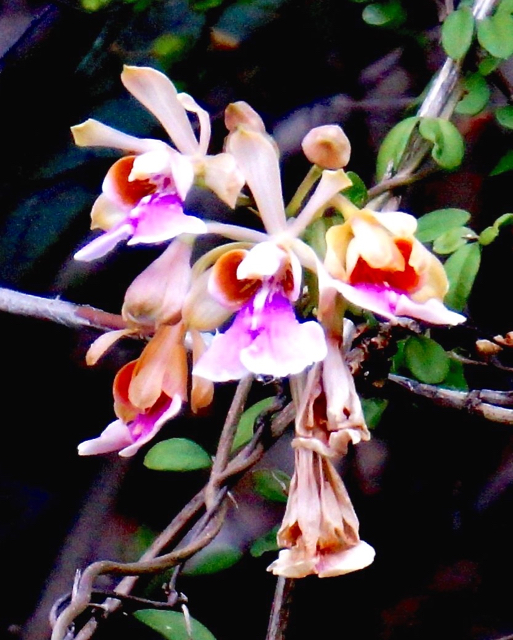
Karlsson’s book is designed to make it easy for residents and visitors to identify common local trees and shrubs by two simple methods.
The first is by leading readers on a walking tour of the trees of Cruz Bay. Beginning at the Cruz Bay ferry dock, the book draws the readers’ attention to the line of coconut palms immediately to their left as they step off the boat, explaining that the trees aren’t technically a native species.
“They probably arrived in the Caribbean less than 500 years ago,” Karlsson wrote, “but are considered to be naturalized.” (Those particular trees were planted, she noted.)
Using the photos, maps, and pithy text, readers can use the book to identify individual trees as they wend their way around Cruz Bay, pausing to notice the leaves, bark, flowers, and fruits, among other characteristics, so that they can recognize the next Genip, Gri-gri, or Poui they encounter.
But if strolling around Cruz Bay is not an option at the moment, the second half of Karlsson’s book offers another method for tree and shrub identification. It is organized by distinguishing characteristics, such as flowers, seeds, or the presence of thorns. A person glancing out the window and noticing a shrub covered with white flowers can thumb through the white flower section of the book to determine if the foliage in question is a Cakalaka Berry or a Rat Bean.
“Although trees and plants help define our sense of place and geography, for many people it is challenging to differentiate unfamiliar species,” Karlsson explained in the introduction to the second part of the book. “Focusing on distinctive flowers, fruits, or thorns turned out to be useful a starting point for people just beginning to pay attention to trees, although an eye-catching flower or fruit might not actually be that tree’s most important characteristic.”
When it comes to identifying and naming the trees for the book, Karlsson worked with botany experts Kevel Lindsay and Eleanor Gibney to provide the scientific names as well as the most common local names.
Lindsay and Gibney also shared their knowledge of the trees’ use. For example, the Fish Poison tree was used by the Amerindians to “stun fish for easy harvesting.” The Pitch Apple became known as the “Autograph Tree” because “people could scratch messages into the thick leaves.”
The book is loaded with many such quirky facts. What we call a “Maho” tree—the common tree that borders so many of St. John’s north shore beaches – is not truly a Maho tree.
“‘Maho’ is an Amerindian word referring to bark that could be stripped off to make rope,” the book explains. Another name for our beach Maho trees is Haiti-Haiti, though it’s not known if they originated in Haiti, or Tahiti, or somewhere else.

She asked Kevel Lindsay, who had written extensively on local flora, for help identifying the trees, and he steered her to applying for a grant from the Urban and Community Forestry Division of the US Department of Agriculture to produce a book.
Knowing that such a project would be demanding, Karlsson enlisted the folks at the Unitarian Universalist Fellowship on St. John to take it on as a community service project. The group had already encouraged people to learn about and appreciate trees by organizing tree walks and sponsoring Earth Day activities. Suki Buchalter, a member of the UU community, took on many of the administrative tasks, and Mary Zehngut assisted with graphic design.
The UU Fellowship had previously published a book on environmentally safe home cleaning products, so it wasn’t too much of a stretch for them to produce the book about trees, Karlsson said.
“Learning about trees served as a lens through which to consider the meaning of the Unitarian Universalist principle of respect for the interconnected web of existence – deepening out recognition of the degree to which people’s lives have been shaped by the dependence on trees and plants, as well as the impacts we have on the landscapes we inhabit,” she wrote in the book.
The grant has paid for some of the experts’ time, administrative and production tasks, and printing and shipping about 200 books. It also covered the cost of printing labels to identify the trees in Mongoose Junction that are described in the book.
Under the grant conditions, neither the authors nor the Unitarians can make a profit off the book. The handy-sized, spiral-bound book will be sold at several St. John stores. It will also be available as a free PDF download from the UU’s website at uufstjohn.com. (Scroll down the Home Page towards the bottom and click on the link to the Tree Book.)
The UU Fellowship will celebrate the book’s launch at its Nov. 13 Sunday service. The public is invited to attend the 10 a.m. meeting, held at the Great Room of the Gifft Hill School’s Lower Campus. Copies of the book will be available.
Further information is available by contacting Karlsson at gkarlsson@att.net.





